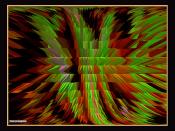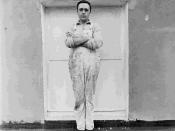Most everything you find on Richter is written in German - I got someone to translate all the information and voila! Enjoy Excellent effort; you must have done considerable research!
Gerhard Richter combines abstract and figurative elements in his paintings to express his own perception of reality. I. Michael Danoff, Director of the Museum of Contemporary Art, Chicago, says of Richter's paintings: 'Ways of seeing are more certain than what is being seen.'
Richter organizes the formal elements space, line, colour, form, repetition and balance to fuse visual and invisible reality into a unified whole.
Born February 9, 1932 in Dresden, East Germany, Richter knew he wanted to become an artist since his mid-teens. In 1951, he was admitted to the Dresden Academy, where he developed his illusionistic painting skills by emulating Casper David Friederich (1774-1840), a leading German Romanic landscape painter. Richter became interested in Modernist painting, and soon realized the political climate in East Germany advocated only the style of Soviet Socialist Realism.
In order to escape the political and artistic oppression, Richter moved to West Germany to continue his education at the Düsseldorf Academy, a major center of the European avant-garde. Fluxus, the 'name taken by an international art movement founded in 1962 to unite members of the extreme avant-garde in Europe and later in the U.S.A. ... in many respects a revival of the spirit of Dada'' influenced Richter. It was in the Fluxus spirit that Richter participated in the now famous performance called 'Life with Pop: A Demonstration for Capitalist Realism' in 1963. Eschewing both the conventional Soviet Socialist painting tradition and the contemporary Capitalist alternatives, Richter invented his own vision of reality an ambiguous mix of avant-garde and tradition that resists categorization.
Over thirty-five years of painting have resulted in an oeuvre that compiles...

![[ R ] Gerhard Richter - 1024 Colors (1973) - Detail](https://s.writework.com/uploads/0/342/r-gerhard-richter-1024-colors-1973-detail-thumb.jpg)
